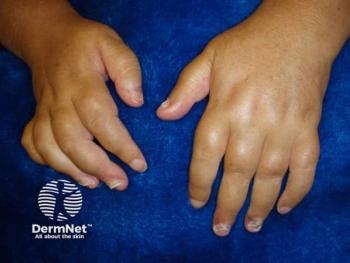
Benefits of Multidisciplinary Care in the Management of GPP
Experts in dermatology provide insight into the importance of multidisciplinary care in the management of patients with generalized pustular psoriasis (GPP).
Episodes in this series

Erin Boh, MD: I will say that after her first, dose administration, which is easy to do, there’s no real prepping or anything like that. You don’t need to premedicate, you don’t need to have long infusion times. Literally, the infusion of the drug is over in about 90 minutes. So, it’s, wham bam, done. Thank you. And she started getting better approximately 24 hours to 36 hours. But I do think part of the slow resolution was the fact that she had some very significant comorbidities that had been jostled. She had chronic renal disease, but when you go into acute renal failure, we were talking about dialysis, so you have all these confounders that I think made her a little bit more difficult to clear any toxins, to clear things that would have maybe gotten her a much quicker response.
The other thing I think is important is, I don’t know if you had it in your patients, but in this one, particularly, she was starting to fluff, but the skin was adherent. It was pustular. So, she’s got this crusty goopy exudate, and we really had to do very local but intensive wound care so much to the point where we were thinking of putting her in our burn unit because she was exfoliating as well as having superficial pustulosis. So, she was already down almost to the dermis. And then she got pustulosis. So, we had to do some intensive local wound care by working with the wound care team doing Xeroform gauze. She looked like a mummy to get all this garbage off her, but they wouldn’t take her to the burn unit because she was on IV [intravenous] antibiotics at the time. And that was a confounder as well.
So, I think there are a lot of things that have to go into taking care of a patient other than just giving them this IV medicine. And that’s where I think a team approach is super helpful, because we don’t, as dermatologists, think about a lot of these other things. We don’t think about high output failure. We don’t think about arrhythmias. You worry about your kidneys and your liver, but if they’re already in bad shape, you say, “Oh, they have renal disease.” So, I think you have to be on your guard. And so, it’s good to have a team approach when it’s a medical emergency like that.
Mark Lebwohl, MD: I will say, you said one other thing in the story that is so typical. The patient had been treated with prednisone, and that is by far the most common cause. The withdrawal of systemic steroids precipitates the outbreak of pustular psoriasis. And I vividly remember the first patient I ever saw with generalized pustular psoriasis, was a 28-year-old nurse at Mount Sinai Hospital in New York, New York, who had very minor psoriasis, a few minor patches on her elbows, but she had psoriatic arthritis. And she went to a rheumatologist who gave her 20 mg of prednisone and it got better. And as he lowered the prednisone, when he went down to 10 mg, she broke out in generalized pustular psoriasis. So, he went back up to 20 mg, and nothing happened. So, he went up to 30 mg and she thought he was great. Everything cleared up. She went from 30 mg down to 20 mg, broke out in pustular psoriasis, went back up to 30 mg, and nothing happened. Then went up to 40 mg. And they kept playing this game, where he kept trying to lower the prednisone and every time he did, she’d break out in pustular psoriasis. By the time I saw her, she had been on more than 100 mg of prednisone a day for more than 6 months. She was grossly cushingoid and doing terribly.
Fortunately, today we have spesolimab, but in 1968 and 1971, there are 2 articles published in the British Journal of Dermatology by Terence J. Ryan, DM, BM BCH Oxon, FRCP, Northampton General Hospital Radcliffe Infirmary, Oxford, UK, and Harvey Baker, MD, MRCP, MB ChB, FRCP; died 2019; The London Hospital, UK on a large cohort of patients with pustular psoriasis, generalized pustular psoriasis, and those patients were treated with either a methotrexate precursor or systemic steroids. Of the patients who got the systemic steroids, 23% died. And the patients died because of the story I just told you where their physicians kept trying to lower the dose and they ended up breaking out worse and worse. And ultimately, they died of complications of systemic steroids. Many from sepsis, but others from other complications of systemic steroids.
Erin Boh, MD: And you had told me that in our initial conversation. And I used that little pearl that you told me that yes, the withdrawal, the steroids are very much a trigger. So, my patient was tapering down. I put her back on steroids and I know that’s a cardinal rule not to do. But when they’ve been on high doses and you suddenly withdraw steroids, I think just to keep it from progressing even worse and accelerating the progression, I opted to put her back on steroids. Plus, I had nothing else. But what you told me I quoted and said, for every 10 mg or so of prednisone that the patients are on daily, you increase their mortality risk significantly.
Transcript Edited for Clarity
Newsletter
Like what you’re reading? Subscribe to Dermatology Times for weekly updates on therapies, innovations, and real-world practice tips.























